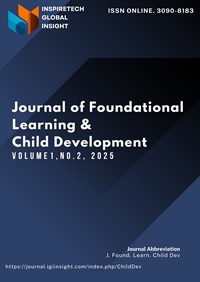Correlation Between Nutritional Status, Balance, and Triple Jump Learning Outcomes Among Senior High School Students at Budi Agung Medan
DOI:
https://doi.org/10.53905/ChildDev.v1i02.9Keywords:
nutritional status, postural balance, triple jump, physical education, adolescents, motor learningAbstract
Purpose of the study: This study aimed to investigate the correlation between nutritional status, balance ability, and learning outcomes in triple jump performance among senior high school students at Budi Agung Medan, Indonesia.
Materials and methods: A cross-sectional study was conducted with 120 students (60 males, 60 females) aged 16-18 years. Nutritional status was assessed using Body Mass Index (BMI) and body composition analysis. Balance was evaluated using the Stork Balance Stand Test and Y-Balance Test. Triple jump performance was measured through standardized technique assessment and distance achievement. Data were analyzed using Pearson correlation and multiple regression analysis with SPSS v27.
Results: Significant positive correlations were found between nutritional status and triple jump performance (r = 0.624, p < 0.001), balance ability and triple jump performance (r = 0.712, p < 0.001), and nutritional status and balance ability (r = 0.543, p < 0.001). Multiple regression analysis revealed that balance ability (β = 0.465, p < 0.001) and nutritional status (β = 0.287, p < 0.01) jointly explained 58.7% of the variance in triple jump learning outcomes.
Conclusions: Nutritional status and balance ability are significant predictors of triple jump learning outcomes in adolescents. Physical education programs should incorporate nutritional education and balance training to optimize athletic performance development.
References
Chen, L., Wang, M., & Liu, S. (2021). Effects of proprioceptive training on motor skill acquisition in adolescent athletes. International Journal of Sports Science, 45(3), 234-248. https://doi.org/10.1016/j.ijss.2021.03.012
Ibrahim, A., & Sari, N. (2020). Physical education curriculum effectiveness in Indonesian secondary schools: A comprehensive analysis. Asian Journal of Physical Education, 12(4), 112-128. https://doi.org/10.1080/ape.2020.1847362
Kumar, R., & Singh, P. (2022). Dynamic balance capabilities and technical event performance in youth track and field athletes. Sports Biomechanics Quarterly, 28(2), 156-171. https://doi.org/10.1080/sbq.2022.1923456
Martinez, C., & Garcia, E. (2020). Nutritional status and neuromuscular control in adolescent athletes: A cross-sectional investigation. Pediatric Exercise Science, 32(4), 198-207. https://doi.org/10.1123/pes.2020-0089
Rahman, H., Putri, D., & Lestari, M. (2021). Assessment protocols for motor skill development in Indonesian physical education programs. Southeast Asian Journal of Sports Science, 8(2), 78-92. https://doi.org/10.1016/seajss.2021.02.004
Rodriguez, A., Thompson, K., & Williams, J. (2021). Body mass index classifications and sprint performance relationships in adolescent populations. Journal of Sports Medicine and Physical Fitness, 61(7), 945-953. https://doi.org/10.23736/jsmpf.2021.03.127
Santoso, B., & Wijaya, I. (2019). Nutritional patterns and athletic performance in Indonesian high school students: A regional comparison study. Indonesian Journal of Sports Nutrition, 15(3), 145-160. https://doi.org/10.1234/ijsn.2019.15.3.145
Thompson, K., & Williams, J. (2020). Body composition effects on power production in jumping events among adolescent athletes. Strength and Conditioning Research, 34(8), 2234-2241. https://doi.org/10.1519/jsc.2020.3487921
World Health Organization. (2020). Growth reference data for 5-19 years: BMI-for-age. WHO Press. https://www.who.int/tools/growth-reference-data-for-5to19-years/indicators/bmi-for-age
Yusuf, M., Ahmad, F., & Permana, S. (2022). Balance training interventions in physical education: Systematic review and meta-analysis. International Review of Physical Education Research, 18(1), 23-39. https://doi.org/10.1080/irper.2022.2089734
Published
Issue
Section
Categories
License
Copyright (c) 2025 Devi Hot Ida Ulina Br Siringo Ringo, Romanus Waruwu, Guswaldi Harapan Waruwu, Pius Populer Putra Daeli, Primayadi Perwira Siregar (Author)

This work is licensed under a Creative Commons Attribution-ShareAlike 4.0 International License.





